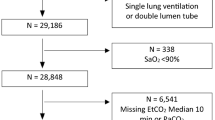Abstract
The development of organ dysfunction is a key contributor to morbidity and mortality in sepsis. End-tidal carbon dioxide levels measured by non-invasive end-tidal capnography (ETCO2) may provide a rapid assessment of a patient’s underlying metabolic status. The objective of this study was to explore the association between ETCO2 and (1) organ dysfunction [sequential organ failure assessment (SOFA) score], and (2) serum lactate levels in febrile emergency department (ED) patients. Prospective, observational cohort study of a convenience sample of 97 adult (age 18 years or older) patients presented to an academic urban ED with a fever and suspected infection. The outcomes were ED SOFA score and serum lactate level. Based on prior studies, we categorized an ETCO2 <35 mmHg, a priori, as abnormal for the exposure. We defined clinically significant organ failure as a SOFA score of >2, and an abnormal lactate as >4 mmol/L. The correlation of ETCO2 with SOFA and lactate level was analyzed using Pearson correlation coefficient. Operating characteristics were calculated with 95% confidence intervals, along with the area under the curve (AUC). Among 97 patients enrolled, 5 (5%) had an abnormal lactate and 34 (35%) had a SOFA score >2. A significant correlation was found between ETCO2 and SOFA score (r = −0.35, p < 0.01), and ETCO2 and lactate level (r = −0.35, p < 0.01). A receiver operator curve for ETCO2 and SOFA >2 had an AUC of 0.69. ETCO2 of <35 has a sensitivity of 0.73 (95% CI 0.56–0.85) and specificity 0.50 (0.38–0.62) in predicting SOFA scores >2. ETCO2 <35 has a sensitivity of 0.60 (0.22–0.88) and specificity 0.42 (0.32–0.52) in predicting lactate >4 with an AUC of 0.62. We found a small, but statistically significant correlation, between ETCO2 and SOFA scores; however, based on questionable operating characteristics, the test seems to have limited ability to meaningfully impact clinical decision making. Larger confirmatory studies are required before final assessment.

Similar content being viewed by others
References
Strehlow MC, Emond SD, Shapiro NI, Pelletier AJ, Camargo CA Jr (2006) National study of emergency department visits for sepsis, 1992 to 2001. Ann Emerg Med 48(3):326–331, 331 e321–323
Ferreira FL, Bota DP, Bross A, Melot C, Vincent JL (2001) Serial evaluation of the SOFA score to predict outcome in critically ill patients. JAMA 286(14):1754–1758
Shapiro NI, Howell MD, Talmor D et al (2005) Serum lactate as a predictor of mortality in emergency department patients with infection. Ann Emerg Med 45(5):524–528
Deakin CD, Sado DM, Coats TJ, Davies G (2004) Prehospital end-tidal carbon dioxide concentration and outcome in major trauma. J Trauma 57(1):65–68
Shapiro NI, Wolfe RE, Moore RB, Smith E, Burdick E, Bates DW (2003) Mortality in Emergency Department Sepsis (MEDS) score: a prospectively derived and validated clinical prediction rule. Crit Care Med 31(3):670–675
Rivers E, Nguyen B, Havstad S et al (2001) Early goal-directed therapy in the treatment of severe sepsis and septic shock. N Engl J Med 345:1368–1377
Garcia E, Abramo TJ, Okada P, Guzman DD, Reisch JS, Wiebe RA (2003) Capnometry for noninvasive continuous monitoring of metabolic status in pediatric diabetic ketoacidosis. Crit Care Med 31(10):2539–2543
Fearon DM, Steele DW (2002) End-tidal carbon dioxide predicts the presence and severity of acidosis in children with diabetes. Acad Emerg Med 9(12):1373–1378
Nagler J, Wright RO, Krauss B (2006) End-tidal carbon dioxide as a measure of acidosis among children with gastroenteritis. Pediatrics 118(1):260–267
Santos LJ, Varon J, Pic-Aluas L, Combs AH (1994) Practical uses of end-tidal carbon dioxide monitoring in the emergency department. J Emerg Med 12(5):633–644
Author information
Authors and Affiliations
Corresponding author
Additional information
An erratum to this article can be found at http://dx.doi.org/10.1007/s11739-008-0221-4
Rights and permissions
About this article
Cite this article
McGillicuddy, D.C., Tang, A., Cataldo, L. et al. Evaluation of end-tidal carbon dioxide role in predicting elevated SOFA scores and lactic acidosis. Intern Emerg Med 4, 41–44 (2009). https://doi.org/10.1007/s11739-008-0153-z
Received:
Accepted:
Published:
Issue Date:
DOI: https://doi.org/10.1007/s11739-008-0153-z




